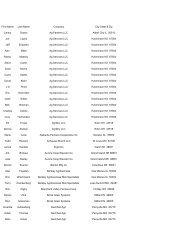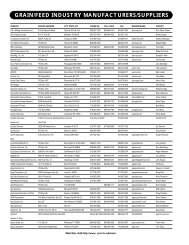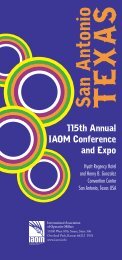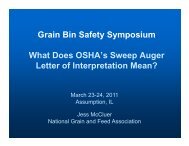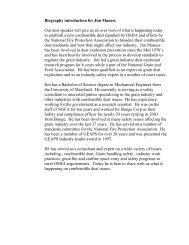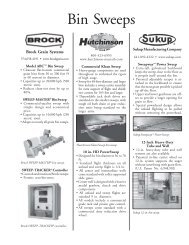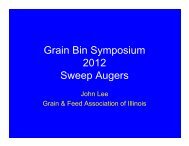What is GIPSA's Unified Grain Moisture Algorithm (UGMA)?
What is GIPSA's Unified Grain Moisture Algorithm (UGMA)?
What is GIPSA's Unified Grain Moisture Algorithm (UGMA)?
You also want an ePaper? Increase the reach of your titles
YUMPU automatically turns print PDFs into web optimized ePapers that Google loves.
Update on USDA’s Transition to New<br />
Official Mo<strong>is</strong>ture Technology<br />
Randall Jones, Deputy Admin<strong>is</strong>trator, GIPSA<br />
David Funk, Chief Scient<strong>is</strong>t, GIPSA<br />
United States Department of Agriculture<br />
<strong>Grain</strong> Inspection, Packers and Stockyards Admin<strong>is</strong>tration<br />
Federal <strong>Grain</strong> Inspection Service
•<br />
•<br />
M<strong>is</strong>sion of Federal <strong>Grain</strong> Inspection<br />
Service (FGIS)<br />
The m<strong>is</strong>sion of the Federal <strong>Grain</strong> Inspection<br />
Service <strong>is</strong> twofold:<br />
–<br />
–<br />
Promote the marketing of high‐quality grain to<br />
domestic and international buyers<br />
Maintain objective standards for grain to certify its<br />
quality as accurately as possible<br />
In admin<strong>is</strong>tering and enforcing the U.S. <strong>Grain</strong><br />
Standards Act, FGIS establ<strong>is</strong>hes methods and<br />
procedures and approves equipment for the<br />
official inspection and weighing of grain.
•<br />
•<br />
•<br />
GIPSA’s<br />
Technology and Science<br />
Div<strong>is</strong>ion<br />
<strong>GIPSA's</strong> reference methods and laboratories are<br />
integral components of the official inspection<br />
system<br />
The data from these labs are used to calibrate<br />
field instruments and/or methods to<br />
internationally recognized reference methods,<br />
which encourages worldwide confidence in our<br />
official inspection results<br />
GIPSA maintains reference methods for mo<strong>is</strong>ture,<br />
protein, oil, starch, mycotoxins, and fatty acid<br />
composition.
•<br />
•<br />
•<br />
H<strong>is</strong>tory of Official Mo<strong>is</strong>ture Meters<br />
1960 ‐ Motomco Model 919 Mo<strong>is</strong>ture Meter<br />
approved for use<br />
1998 ‐ GAC 2100 manufactured by Dickey‐<br />
john Corporation replaced the Motomco<br />
meter<br />
On April 11, 2012, GIPSA announced its<br />
approval of two <strong>UGMA</strong>‐Compatible mo<strong>is</strong>ture<br />
meters, the DICKEY‐john GAC 2500<strong>UGMA</strong>,<br />
and the Perten AM 5200‐A.
New Generation Official Mo<strong>is</strong>ture Meter<br />
•<br />
•<br />
Dr. David B. Funk led a 10‐year research and<br />
development initiative to develop a new<br />
generation of instruments to measure<br />
mo<strong>is</strong>ture in grain. The result was the <strong>Unified</strong><br />
<strong>Grain</strong> Mo<strong>is</strong>ture <strong>Algorithm</strong> (<strong>UGMA</strong>).<br />
GIPSA made Dr. Funk's work freely available<br />
as a public algorithm to facilitate adoption by<br />
multiple manufacturers.
•<br />
•<br />
•<br />
•<br />
•<br />
•<br />
•<br />
•<br />
•<br />
<strong>What</strong> <strong>is</strong> GIPSA’s<br />
<strong>Unified</strong> <strong>Grain</strong><br />
Mo<strong>is</strong>ture <strong>Algorithm</strong> (<strong>UGMA</strong>)?<br />
Very accurate dielectric‐type mo<strong>is</strong>ture method<br />
Higher measurement frequency (about 150 MHz)<br />
Based on a defined physical parameter—Dielectric<br />
Constant<br />
Excellent density correction<br />
Three “unifying parameters” per grain group<br />
A single calibration “curve” for all grain types<br />
Prec<strong>is</strong>e, wide‐range temperature correction<br />
Calibrated to GIPSA’s standard Air Oven method<br />
“Open”—Available to any manufacturer
<strong>UGMA</strong> Master System<br />
Master Test<br />
Agilent E4991A Impedance Analyzer<br />
7
User<br />
Manufacturer<br />
GIPSA<br />
Instrument<br />
Parameters<br />
Test Cell<br />
Parameters<br />
<strong>Unified</strong> <strong>Grain</strong> Mo<strong>is</strong>ture <strong>Algorithm</strong><br />
Z, d, etc.<br />
Polynomial<br />
Coefficients<br />
Cell<br />
Volume<br />
Mass<br />
Sensor<br />
FF, corr<br />
Sample<br />
Mass<br />
<strong>Grain</strong> Sample <strong>Grain</strong> Type<br />
Z* or Γ*<br />
Sensor<br />
SFG or<br />
ABCD Model<br />
Secondary<br />
Corrections<br />
ε effective<br />
ε` r<br />
Density<br />
Correction<br />
Unifying<br />
Parameters<br />
Polynomial<br />
Equation<br />
Temperature<br />
Correction<br />
Mo<strong>is</strong>ture<br />
Result<br />
Γ*<br />
ε` density corrected<br />
ε` unified<br />
%M<br />
%M TC<br />
T<br />
Temp.<br />
Sensor<br />
Unifying<br />
Parameters<br />
Temp. Corr.<br />
Parameters<br />
D.B. Funk<br />
November 9, 2006<br />
GROUP ID<br />
Type-Group<br />
Table
Why<br />
change to <strong>UGMA</strong>?
Improved Accuracy for All <strong>Grain</strong> Types<br />
2011 Corn Crop<br />
GAC 2100 <strong>UGMA</strong>
Improved Accuracy of <strong>UGMA</strong><br />
11
Improved Accuracy of <strong>UGMA</strong><br />
12
Improved Year‐to‐Year<br />
Calibration Stability
GAC 2100<br />
Corn<br />
0,3<br />
0,2<br />
0,1<br />
0,0<br />
-0,1<br />
-0,2<br />
-0,3<br />
<strong>UGMA</strong><br />
1998 1999 2000 2001 2002 2003 2004 2005 2006<br />
1 yr 3 yr
Sunflower<br />
GAC 2100 0.2 <strong>UGMA</strong><br />
0.3<br />
0.1<br />
0.0<br />
-0.1<br />
-0.2<br />
-0.3<br />
1998 1999 2000 2001 2002 2003 2004 2005 2006<br />
1 yr 3 yr
Soft Red Winter Wheat<br />
GAC 2100 0.2 <strong>UGMA</strong><br />
0.3<br />
0.1<br />
0.0<br />
-0.1<br />
-0.2<br />
-0.3<br />
1998 1999 2000 2001 2002 2003 2004 2005 2006<br />
1 yr 3 yr
Long <strong>Grain</strong> Rough Rice<br />
GAC 2100<br />
0.3<br />
0.2<br />
0.1<br />
0.0<br />
-0.1<br />
-0.2<br />
-0.3<br />
<strong>UGMA</strong><br />
1998 1999 2000 2001 2002 2003 2004 2005 2006<br />
1 yr 3 yr
Drastically Improved Accuracy on<br />
High and Low Test Weight Corn
GAC 2100 Corn Results—Density Issue<br />
Accuracy for 2007‐2009 Crops<br />
For range:<br />
Samples:<br />
Std. Dev. of Diff:<br />
10‐36% M<br />
686<br />
0.70% M<br />
Low TW samples yielded low mo<strong>is</strong>ture results.
TEST WEIGHT<br />
65<br />
60<br />
55<br />
50<br />
45<br />
Corn: Official Test Weight vs.<br />
Air Oven Mo<strong>is</strong>ture<br />
The drastic change in test weight with mo<strong>is</strong>ture<br />
for normal corn presents special challenges for<br />
density correction of corn mo<strong>is</strong>ture measurements.<br />
40<br />
9 11 13 15 17 19 21 23 25 27 29 31 33 35 37 39 41 43 45<br />
AIR OVEN % MOISTURE
Mo<strong>is</strong>ture Prediction Error, %M<br />
3<br />
2<br />
1<br />
0<br />
1<br />
2<br />
Secondary Density Correction<br />
Corn Results for <strong>UGMA</strong><br />
Before Correction After Correction<br />
2<br />
3<br />
0 10 20 30 40<br />
Air Oven Mo<strong>is</strong>ture, %M<br />
Before Bias STD Slope After Bias STD Slope<br />
All Samples -0.04 0.46 -0.01 All Samples -0.01 0.31 -0.01<br />
Low<br />
Density -0.66 0.34 0.00<br />
2 Normal Corn<br />
Low Density Corn<br />
3<br />
0 10 20 30 40 50<br />
Low<br />
Density -0.11 0.32 -0.03<br />
Normal 0.09 0.36 -0.04 Normal 0.01 0.30 -0.01<br />
3<br />
1<br />
0<br />
1<br />
Air Oven Mo<strong>is</strong>ture, %M
Wider Sample Temperature Ranges<br />
GAC 2100<br />
32 °F<br />
103 °F<br />
113 °F<br />
<strong>UGMA</strong><br />
0 °F
Mo<strong>is</strong>ture Error due to Rapid Drying (%)<br />
“Green”<br />
<br />
<br />
<br />
0<br />
5<br />
10<br />
<strong>Grain</strong> Effects Reduced<br />
Long <strong>Grain</strong> Rough Rice Rebound<br />
GAC 2100<br />
<strong>UGMA</strong><br />
15<br />
10 15 20 25 30<br />
Mo<strong>is</strong>ture Content of the Dried Sample, M%
Error due to Mixture of Wet and Dry Rice (%)<br />
“Green”<br />
<br />
0.5<br />
<br />
1<br />
0.5<br />
0<br />
<strong>Grain</strong> Effects Reduced<br />
GAC 2100<br />
<strong>UGMA</strong><br />
LGRR Mixture Effects<br />
1<br />
15 20 25 30 35<br />
Mo<strong>is</strong>ture Content of the Wet Component, M%
Mo<strong>is</strong>ture Error due to Mixture (%)<br />
“Green”<br />
<br />
<br />
2<br />
1<br />
0<br />
1<br />
GAC 2100<br />
<strong>UGMA</strong><br />
<strong>Grain</strong> Effects Reduced<br />
Effects of Mixtures of Wet and Dry Soybeans<br />
2<br />
10 15 20 25 30<br />
Mo<strong>is</strong>ture of Wet Component of Mixture (%)
GIPSA‐Certified <strong>UGMA</strong>‐Compatible<br />
Mo<strong>is</strong>ture Meters<br />
Dickey‐john GAC 2500<strong>UGMA</strong> Perten<br />
AM 5200‐A<br />
26
GIPSA’s<br />
•<br />
•<br />
•<br />
Basic Definition of Equivalency<br />
Same technology<br />
Very close agreement among types as well as<br />
units of a type<br />
Same calibrations and standardization<br />
processes<br />
27
•<br />
•<br />
•<br />
•<br />
•<br />
•<br />
<strong>UGMA</strong>‐Compatibility Criteria (1)<br />
NTEP Certification<br />
Documented & stable production processes<br />
Measurement frequency<br />
Standardized test cell design<br />
Standardized loading method<br />
Standardized measurements<br />
–<br />
–<br />
–<br />
Sample dielectric constant<br />
Sample mass<br />
Sample temperature<br />
28
•<br />
•<br />
•<br />
<strong>UGMA</strong>‐Compatibility Criteria (2)<br />
Tight tolerances specified for individual<br />
subsystems as well as mo<strong>is</strong>ture results<br />
Must use specified mathematics<br />
Units’ agreement with FGIS Master system<br />
must meet tolerances in FGIS Regulations<br />
–<br />
–<br />
–<br />
+/‐<br />
+/‐<br />
0.05% M for Headquarters Standard units<br />
0.15% M for other Official units<br />
Mean difference on medium‐mo<strong>is</strong>ture HRWW<br />
29
•<br />
•<br />
•<br />
•<br />
<strong>UGMA</strong>‐Compatibility Criteria (3)<br />
All <strong>UGMA</strong>‐Compatible models must be able to<br />
use the same check testing process.<br />
A simple check testing process must ensure<br />
performance on all grains over full mo<strong>is</strong>ture<br />
ranges.<br />
Instruments must provide for efficient means<br />
of entering calibrations.<br />
Instruments must provide standardized<br />
output data stream for printing or<br />
networking.<br />
30
Excellent Agreement Between<br />
<strong>UGMA</strong> Models<br />
31
Excellent Agreement Between<br />
<strong>UGMA</strong> Models<br />
Check Testing Tolerance for Official Mo<strong>is</strong>ture Meters<br />
32
Far Better Agreement Than<br />
Between Different Technologies<br />
33
Far Better Agreement Than<br />
Between Different Technologies<br />
34
•<br />
•<br />
•<br />
•<br />
Anticipated Mo<strong>is</strong>ture Changes with<br />
Transition to <strong>UGMA</strong><br />
GAC 2100 and new <strong>UGMA</strong> –based meters are all calibrated<br />
to agree with GIPSA’s air oven method as closely as<br />
possible.<br />
Do not expect significant average differences between GAC<br />
2100 and new <strong>UGMA</strong>‐based meters—except:<br />
Low test weight corn mo<strong>is</strong>ture values will generally<br />
increase:<br />
–<br />
GAC 2100 reads lower than <strong>UGMA</strong> by 0.2% per pound per<br />
bushel below 57 lb/bu<br />
High test weight corn mo<strong>is</strong>ture values will generally<br />
decrease:<br />
–<br />
GAC 2100 reads higher than <strong>UGMA</strong> by 0.2% per pound per<br />
bushel above 57 lb/bu
United States Department of Agriculture<br />
<strong>Grain</strong> Inspection, Packers and Stockyards Admin<strong>is</strong>tration<br />
Federal <strong>Grain</strong> Inspection Service<br />
36






